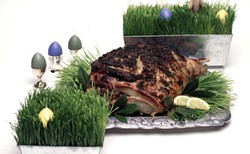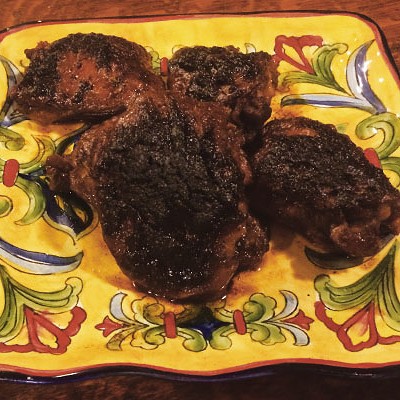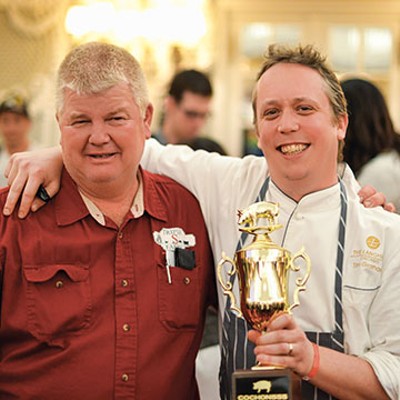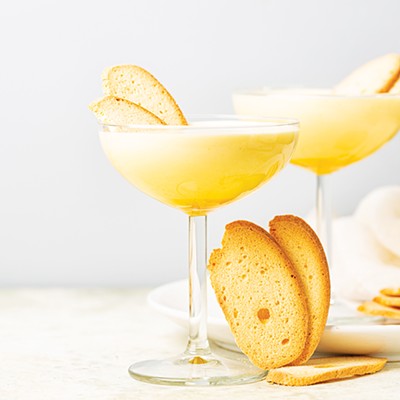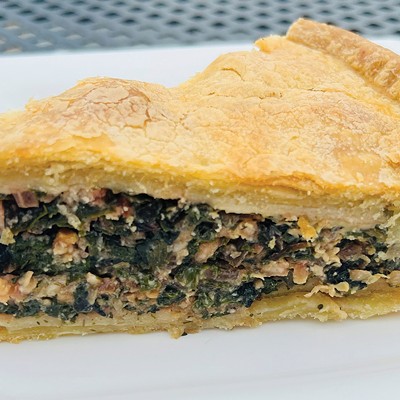The correlation between lamb and Easter is obvious: lamb and spring, Lamb of God, etc. But I never understood the ham connection until recently. Pigs were typically slaughtered in late fall. Since hams had to be cured, smoked and aged, they’d be ready just in time for Easter.
Nana’s lamb is glorious in its simplicity. It’s hard for me to not fiddle with recipes; I’ve substituted wine for water and added different seasonings; none has ever come close to the original.
My grandmother’s roast leg of lamb
- 1 leg of lamb. If boneless, it should weigh about 4-6 lbs. Bone-in roasts can be as large as 8 lbs. Semi-boneless legs are in-between.
- Garlic cloves
- Fresh rosemary needles (leaves), optional
- Salt and freshly ground black pepper
For the gravy:
- 2 T. of all-purpose flour per c. of water
- Salt and freshly ground pepper to taste
- Worcestershire sauce
Remove the lamb from the refrigerator at least two hours before you plan to begin roasting.
Peel the garlic cloves and cut them into thin slivers. How many you need depends on the size of the roast and your garlic passion.
While the roast is cold, with a small sharp knife, make an incision deep enough to pierce its fat cap and get into the meat, about 2 inches. Insert a garlic sliver, along with a couple of rosemary needles, if using. It’s OK if bits of garlic and rosemary protrude from the surface. Repeat all over the top (the part with the fat cap) and sides of the meat. Generously season the lamb all over with salt and pepper.
Set aside to come to room temperature.
Preheat oven to 500 F.
Put the lamb in a large roasting pan then place it in the oven.
Roast for 15-30 minutes. Smaller roasts need less time; larger more. Regardless, there should be a delicious smell of browning (not burning) meat and a good amount of fat and juice on the pan’s bottom.
Reduce heat to 325 F. Continue roasting until internal temperature (using an instant-read thermometer thrust into the thickest part of the meat without touching the bone) reaches 135 F (medium-rare), 145-150 F for medium (my preference) and 160 F for medium-well. This usually takes another 40-90 minutes, again, depending on the roast’s size; also, bone-in roasts take longer.
Remove the roast to a heat-proof platter; tent loosely with foil. Let stand at least 15-20 minutes in a warm place, or even a bit longer if kept nicely warm. The roast’s internal temperature should rise another 5-10 F during this resting period.
While the roast stands, make the gravy. Pour off excess fat and pan juices from the pan, but do not scrape away all the fat or, especially, browned bits. Put excess fat and juices in a glass container. Set aside.
Put tepid-to-warm water for the amount of gravy you’ll need in a large jar with a sealable lid. For a whole leg of lamb, use at least 4 cups of water; less if your roast is smaller. Add two tablespoons of flour for every cup of water. Close tightly, shaking vigorously to make a slurry. (Can also be done with a whisk, blender or an immersion blender.
Put the pan over medium heat. When hot, add the slurry in a thin stream, whisking constantly and scraping up the browned stuff on the pan’s bottom, called fond (pronounced FAW); that’s what gives the gravy its gorgeous flavor.
Check the poured-off fat and pan juices. The juices will have fallen to the bottom. Spoon off all fat possible, then add the juices back to the pan. Skip this if there are just a few browned bits and little or no pan liquids.
Continue stirring and scraping, incorporating all that flavorful fond, until the gravy is your desired consistency. Season with salt, pepper and a few drops of Worcestershire sauce.
For a delectable twist on your family’s traditional ham, try this fresh (aka uncured and unsmoked) ham. An aromatic brine maximizes taste and juiciness; the mustard/herb rub and cider glaze provide perfect counterpoints to its luxurious porkiness.
Fresh roast ham with a cider glaze
For the brine:
- 30 c. cold water
- 2 c. kosher salt
- 1 c. firmly packed brown sugar
- 2 c. cider vinegar
- 1 T. whole allspice or cloves
- 6 bay leaves
- 1 T. whole mustard seeds
- 1 T. whole coriander seeds
- 2 T. black peppercorns
- 1 8-10 lb. shank end fresh ham, bone-in and skin-on
For the rub and glaze:
- 1/4 c. room temperature bacon fat (preferred) or vegetable oil
- 1/4 c. Dijon-type mustard
- 1/4 c. minced fresh thyme or marjoram
- Freshly ground black pepper
- 4 bay leaves
- 4 large onions, not super-sweet, peeled, trimmed and cut into inch-thick slices
- 1 gallon apple cider
- Cider vinegar to taste, optional
- 2 T. all-purpose flour
- 2 T. softened butter
The evening before roasting: In a plastic container large enough to completely hold the ham, stir the water with the salt, brown sugar and 1 cup of the vinegar until the salt and sugar have completely dissolved. Put the remaining cup of vinegar in a small saucepan, add the spices and bring to a boil. Immediately remove the pan from the heat and cool to room temperature.
Score ham in a diamond pattern through the skin and fat, taking care not to cut into the meat. This is easiest to do if the ham is cold. Stir the cooled spice/vinegar mixture into the brine, add the ham, weighting with a plate to keep it submerged. Refrigerate overnight.
The next morning, drain the ham, discarding the brine. Pat dry, then place it on a rack in a cool dry spot. Position it where it will catch breezes from a ceiling fan or put it in front of a stand fan for best drying. Let stand at least 2 hours to dry the surface and come to room temperature.
Preheat the oven to 450 F. Put the bacon fat or oil, the mustard, fresh herbs (not including the bay leaves) and pepper in a food processor and process into a paste. Rub all over the ham, including in the diamond cuts.
In a large roasting pan, place the bay leaves evenly on the bottom, then cover with onion slices. Drizzle 1 cup of cider over the apples. Set the ham on top.
Roast the ham for 30 minutes, then reduce the oven temperature to 325 F. Roast until an instant-read thermometer inserted into the thickest part registers 165 F (without touching the bone), about 4 hours. Check periodically; if the bone begins burning, loosely wrap it in aluminum foil.
Bring the remaining cider to a boil, reduce the heat and simmer, uncovered, until it’s syrupy and reduced to about 2 cups, about 1 1/2 hours. Add a tablespoon or two of cider vinegar for bit of tartness.
After 2 1/2 hours of roasting, begin brushing the ham with the glaze every 30 minutes.
When done, transfer the ham to an ovenproof platter, cover with foil and let it rest in the turned-off oven for 30 minutes. Put the onion slices in a covered bowl in the oven as well.
Strain the pan juices into a saucepan, skim off excess fat and bring to a simmer. Mash the butter and flour together, then whisk bits of this paste (called beurre manié) into the pan until the juices and paste emulsify and the sauce thickens.
Carve the ham; serve with the onions and sauce.
Contact Julianne Glatz at [email protected].

